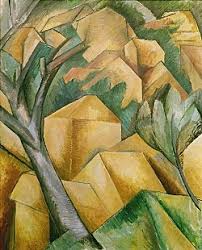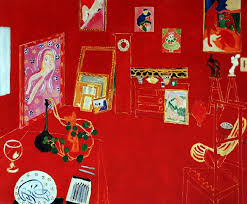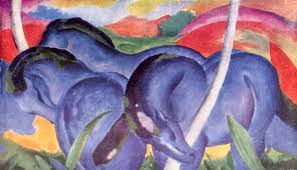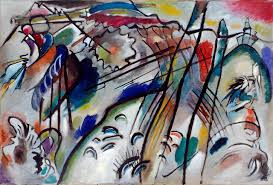Early 20th Century: Modernism I & II
1/15
There's no tags or description
Looks like no tags are added yet.
Name | Mastery | Learn | Test | Matching | Spaced |
|---|
No study sessions yet.
16 Terms
Modern Art
roots in 19th century avant-garde movements, (Impressionism) moving into the 20th century
now a historical period used by muesums

Houses at L’Estaque by George Braque
1908, Cubism, France, oil on canvas
hill side of a mountain, with the yellow as houses and green as trees
utilizing forms to create shape, Braque more focused on shape then color
Abstraction (reductive)
a simplification and/or exaggeration of forms
Abstraction (non-objective)
no reference to the observed world
aka pure abstraction
strictly speaking abstract means to separate from something else
Fauvism
early 20th century, mainly about color, artist came up with the idea that color should have the upper hand

The Red Studio by Henri Matisse
1911, Fauvism, France, oil on canvas
perspective isn’t consistent with the dresser and stool not having another plane
intensity, unified idea of how the studio felt to Matisse
the room is completely draped in red, with no distinct walls or floors
Expressionism
color as expression of emotional state or emotional response (intensified color)
Cubism
spearheaded by Pablo Picasso and Georges Braque, that revolutionized painting by depicting subjects from multiple perspectives and breaking down objects into geometric shapes
Expressionism In Color
Color as building block of composition that may not be naturalistic, no longer descriptive of the observed world used in abstraction
color both creating and confusing pictorial space
What did Moder art ask of color?
Modern art started to ask is color universal or personal
color used to diagram truths about nature of reality
took place after WWI, when the world was still struggling with many tragedies

The Large Blue Horses by Franz Marc
1911, Expressionism, Germany, oil on canvas
Franz Marc had a strong connection to animals, weren’t burdened with human issues like immortality
tried to display harmony in the world with animals
doesn’t separate subject from background, everything flows together
Franz Marc Thoughts on Color
Gendered roles for color:
Blue = Male
Yellow = Female
Red = Brutal Matter

Improvisation 28 by Vasily Kandinsky
1912, Abstraction, Germany, oil on canvas
took all the things that correspond music and put them together in a avant-garde way
Kandinsky had synesthesia, overlapping senses (sight overlapping with hearing)
Kandinsky thought that artists would lead the world into new spirituality
Kandinsky Thoughts on Color
Blue = inner supernatural, sinking towards black
light blue - heavenly
Yellow = warm, cheeky, madness, an attack of rage
Red = alive, restless, manly maturity
vermillion - glowing passion
light red - youth, pure
Alterpiece No. 1 by Hilma Af Klint
1915, Abstraction, Sweden,
tried to get people interested in her work, no one took to it
left all her work to her nephew, told him to wait 20 years , though people still didn’t want her work
geometric forms, spectral sequence (sequence of colors), abstract spiritual ideas
Holma thought her work would best be displayed in a spiral building
a building built in 2018 was able to show all her work in a spiral building
Hilma Af Klint Thoughts On Color
Blue = represent feminine, the powerful real nature, faithful
Yellow = represents the masculine, the splendid color of light, foundations of knowledge